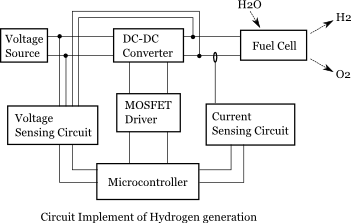Fuel cell outputs electricity and water with hydrogen and oxygen as input materials. You can also use fuel cells in a reverse way; you can get hydrogen and oxygen by feeding fuel cells electricity. It is always easier and cheaper to store hydrogen than electricity. No affordable capacitors and batteries store electric energy as much as a big tank of hydrogen provides equivalent energy. Then it will be a good idea that you withdraw electricity by using fuel cell from hydrogen, bank of energy.
In principle, you can generate hydrogen by connecting fuel cell with electric power source, or simply battery, and with some water. But that's all for the case. All you can do are ON and OFF. You can't put the generation of hydrogen under precise control there. One interest is how we can control the rate of volume of generated hydrogen. To do that, you have to control the feeding current to fuel cell, because the rate is always proportional to current.
Our idea is very common in the field of control engineering and may be described as follows.
It is not true that you can design a circuit even if you are familiar with control theory. You need to learn power electronics, sensor circuit, and microcontrollers. A solution to the problem how we assemble parts to realize system as described by block diagram above is as follows.
Possible research topics include:
- Modelling static electric characteristic (I-V curve) of fuel cell when using it as hydrogen generator
- Examine if linear approximation around a working point on I-V curve is appropriate or not
- Select the type of DC-DC converter to meet a voltage source and a fuel cell you want to use
- Design an experimental setup; that includes choice of electric and electronic parts
- Investigate dynamic electric characteristic of fuel cell; determine how lagged hydrogen generation is behind feeding voltage
- Determine control specification how you want to make the system
- Design sensing circuits enough to provide signals to the microcontroller precisely and rapidly
- Design a MOSFET driver circuit and determine the frequency of switching
- Use negative feedback of the lag and evaluate the feedback system in view of control specification
- Simulate your system on computer and evaluate it with experiment
- Write an algorithm to describe your control law and code it


